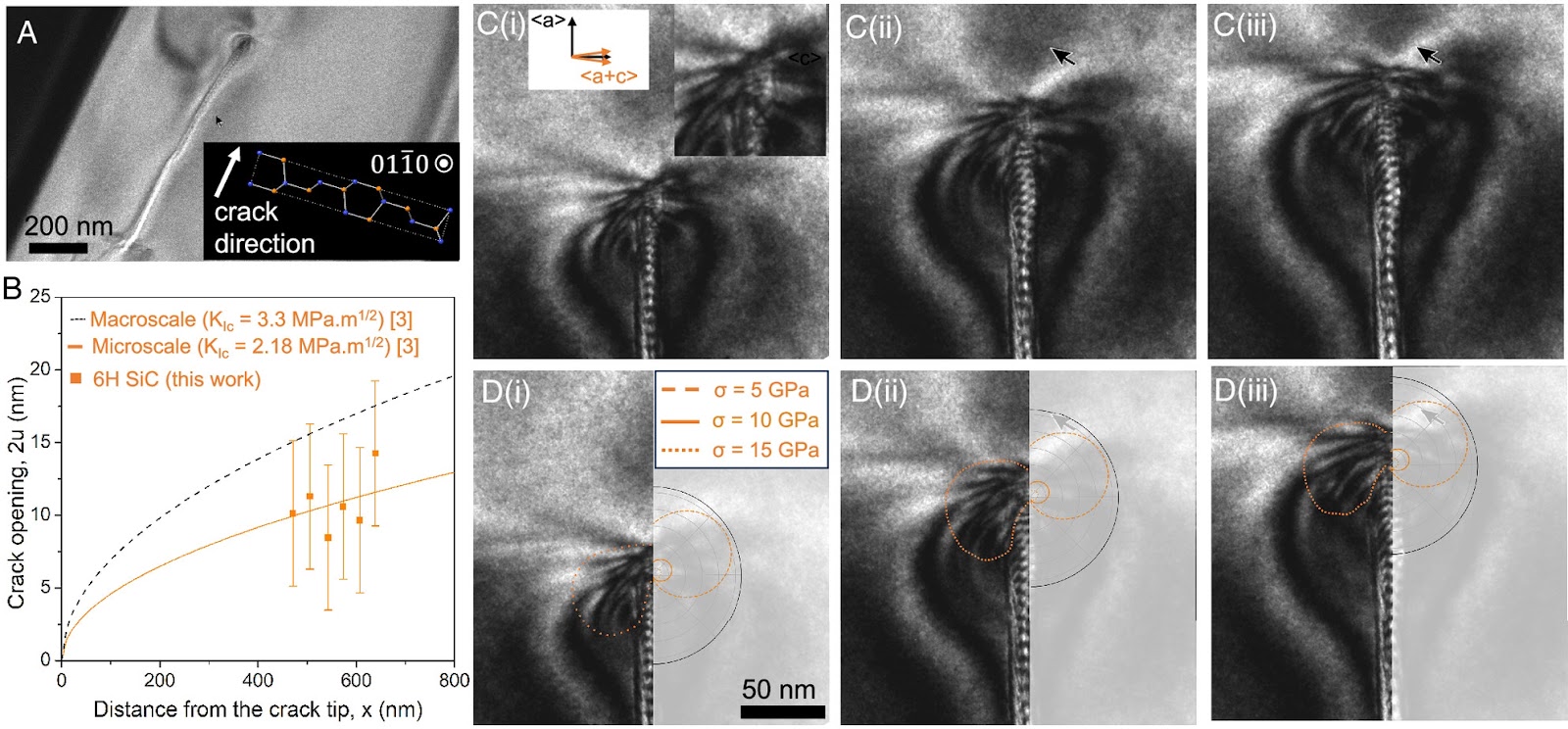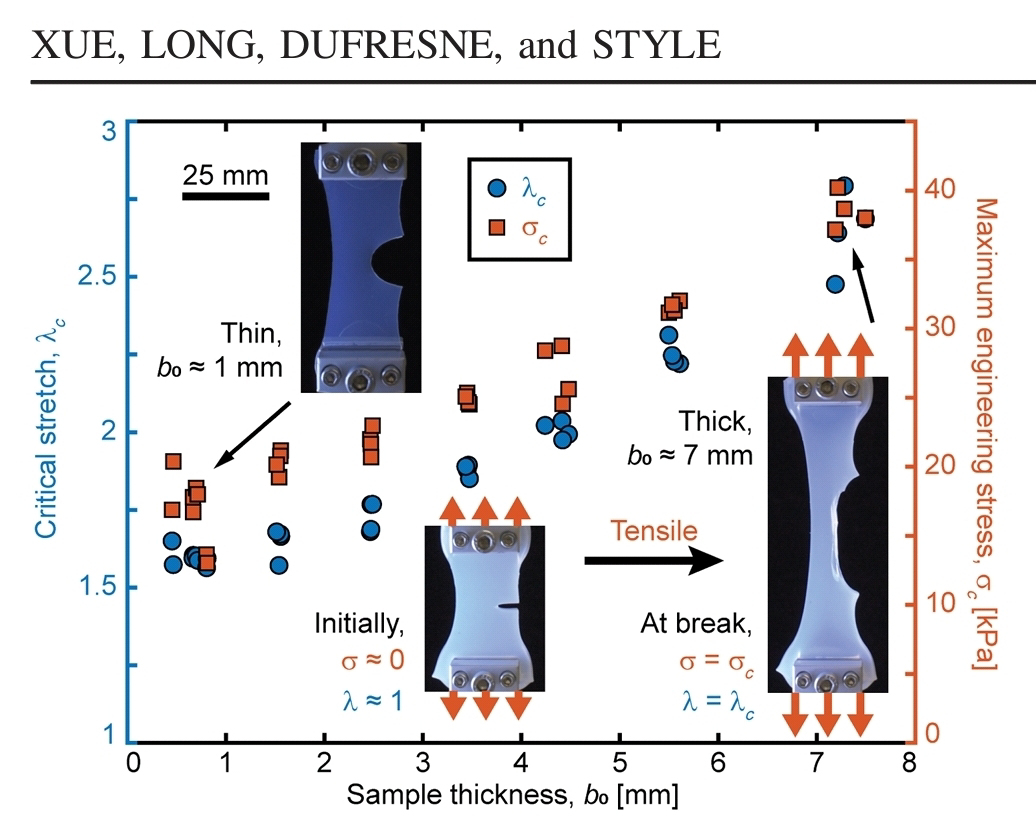Translate
venerdì 26 gennaio 2024
# gst: compression and fracture of ordered and disordered droplet rafts
giovedì 13 marzo 2025
# gst: dynamics of fluid-driven fractures across material heterogeneities.
lunedì 15 settembre 2025
# gst: dual role for heterogeneity in dynamic fracture.
venerdì 1 novembre 2024
# gst: monitoring of stable crack growth; crack tip behavior at the nanoscale (during ceramic fracture).
giovedì 2 marzo 2023
# gst: when science meets poetry, an image of three-dimensional stepped cracks (bistability, and their transition to simple cracks)
mercoledì 28 maggio 2025
# gst: defect-free and defective adaptations of crystalline sheets to stretching deformation.
lunedì 15 marzo 2021
# gst: an atomic imaging of a (slow) crack
mercoledì 3 aprile 2024
# gst: elastomers fail from the edge.
domenica 23 ottobre 2016
# s-gst: multiple cracks, simultaneously ...
<< While the initiation of fracture in brittle solids is generally associated with the preexistence of material imperfections, the mechanism for initiation of fracture in viscoelastic fluids, e.g., polymer melts and solutions, remains an open question. >>
<< The images reveal the simultaneous propagation of multiple cracks >>
<< The critical stress and strain for the onset of crack propagation are found to be highly reproducible functions of the stretch rate, while the position of initiation is completely random >>
Qian Huang, Nicolas J. Alvarez, et al. Multiple Cracks Propagate Simultaneously in Polymer Liquids in Tension. Phys. Rev. Lett. 117, 087801. Publ 15 Aug. 2016
http://journals.aps.org/prl/abstract/10.1103/PhysRevLett.117.087801
Jay Fineberg. How to Fracture a Fluid. Aug.15, 2016
mercoledì 8 ottobre 2025
# gst: self-organized adaptive branching in frangible matter.
lunedì 27 ottobre 2025
# gst: cascade crack in chain of beads.
martedì 29 luglio 2025
# gst: apropos of monopoles with internal degrees of freedom
martedì 7 novembre 2017
# gst: the intriguing dynamics of a crack
<< Cracks develop intricate patterns on the surfaces that they create >>
<< Although fracture mechanics predict that slow crack fronts should be straight and form mirror-like surfaces, facet-forming fronts propagate simultaneously within different planes separated by steps >>
Itamar Kolvin, Gil Cohen & Jay Fineberg. Topological defects govern crack front motion and facet formation on broken surfaces. Nature Materials. doi: 10.1038/nmat5008 Oct 16, 2017
https://www.nature.com/nmat/journal/vaop/ncurrent/full/nmat5008.html
Novel technique reveals the intricate beauty of a cracked glass. Oct 31, 2017
http://new.huji.ac.il/en/article/35974
Intricate beauty of a cracked glass
Physics, math and special gels explain the formation of fracture patterns in brittle materials. Oct 31, 2017
https://www.sciencedaily.com/releases/2017/10/171031111457.htm
martedì 17 giugno 2025
# gst: early warning skill, extrapolation and tipping for accelerating cascades; if the upstream system crosses a tipping point, this can shorten the timescale of valid extrapolation.
sabato 26 agosto 2017
# gst: modeling around the edge of a crack
<< It is said that a weak link determines the strength of the entire chain. Likewise, defects or small cracks in a solid material may ultimately determine the strength of that material – how well it will withstand various forces >>
<< What, exactly, happens right around the edge of the crack, in the area in which those large stresses are concentrated? >>
The Breaking Point. What happens at the moving edge of crack? Aug 23, 2017
https://wis-wander.weizmann.ac.il/chemistry/breaking-point
https://www.sciencedaily.com/releases/2017/08/170823094054.htm
AA << show that cracks undergo an oscillatory instability controlled by small-scale, near crack-tip, elastic nonlinearity. This instability occurs above an ultrahigh critical velocity and features an intrinsic wavelength proportional to the ratio of the fracture energy to the elastic modulus (..) This ratio emerges as a fundamental scaling length assumed to play no role in the classical theory of cracks, but shown here to strongly influence crack dynamics >>
Chih-Hung Chen, Eran Bouchbinder & Alain Karma. Instability in dynamic fracture and the failure of the classical theory of cracks. Nature Physics doi: 10.1038/nphys4237 Publ. Aug 21, 2017
https://www.nature.com/nphys/journal/vaop/ncurrent/full/nphys4237.html
lunedì 9 settembre 2024
# gst: critical crack length during fracture.
lunedì 29 gennaio 2018
# chem: extreme superconductive in random atomic-scale mixture
<< High-entropy alloys (HEAs) are a new class of materials that are composed of multiple transition-metal elements in equimolar or near-equimolar ratios >>
<< many HEAs have been found in disordered solid-solution phases with body-centered-cubic, hexagonal closest-packed, and face-centered-cubic crystal structures >>
<< In many respects, HEAs display novel properties, including ultrahigh fracture toughness at cryogenic temperatures, excellent specific strength, and superior mechanical performance at high temperatures. In addition to their promising mechanical properties, some HEAs also exhibit interesting electronic properties: [TaNb]1−x(ZrHfTi)x HEAs were found to display superconductivity, for example >>
AA << report high-pressure studies on the superconducting HEA (TaNb)0.67(HfZrTi)0.33, [..] this alloy exhibits extraordinarily robust superconductivity - its zero-resistance superconducting state is still achieved even at a pressure of 190.6 GPa, or almost 2 megabars (1 Mbar = 1011 pascal), a pressure like that within the outer core of the earth. >>
Jing Guo, Honghong Wang, et al. Robust zero resistance in a superconducting high-entropy alloy at pressures up to 190 GPa. PNAS 2017; 114 (50) 13144-7. doi: 10.1073/pnas.1716981114.
http://www.pnas.org/content/114/50/13144
Laura Mgrdichian. A material that superconducts continuously up to extreme pressures. Jan 17, 2018
https://m.phys.org/news/2018-01-material-superconducts-extreme-pressures.html






